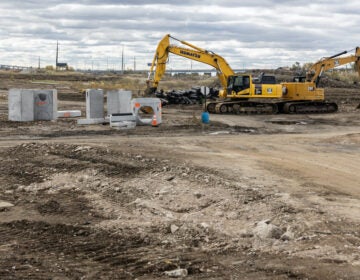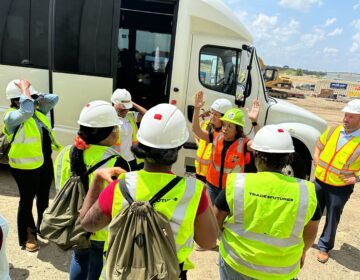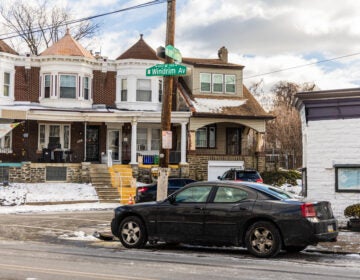The PES refinery redeveloper signed a ‘community benefits commitment’ with 16 groups. Here’s what’s inside
The company has agreed to create a nonprofit to distribute at least $100,000 a year for community initiatives.
Listen 1:20
The former site of the PES Refinery in South Philadelphia is in the construction phase of becoming the Bellwether District in October of 2023. (Kimberly Paynter/WHYY)
Have a question about Philly’s neighborhoods or the systems that shape them? PlanPhilly reporters want to hear from you! Ask us a question or send us a story idea you think we should cover.
Sixteen community groups have agreed to support a “community benefits commitment” with HRP Group, owner of the former oil refinery site along the Schuylkill River, the company said.
A new nonprofit created by the company will distribute at least $1 million over 10 years for community initiatives. The commitment also includes previously announced benefits, such as $3.5 million worth of internships and career activities for School District of Philadelphia students.
The company estimates its total commitment will exceed $10 million over the next decade. That’s much less than the $50 million promised in the community benefits agreement Mayor Cherelle Parker announced last month for the proposed Philadelphia 76ers arena in Center City.
“It’s a starting point, and so you have to start somewhere so that you can move forward,” said Albert Littlepage, president of the Point Breeze Community Development Coalition, a group that’s part of a larger coalition of organizations that decided to support the HRP Group commitment.
The amount the company contributes to the new nonprofit’s fund will depend on HRP’s success in leasing out new warehouses, offices, labs and other buildings it plans to construct on the sprawling, neighborhood-sized property, and some of the other benefits are tied to its participation in a state tax abatement program.
Last week, City Council endorsed HRP Group’s application to extend the property’s eligibility for the Keystone Opportunity Zone program an additional 10 years, to 2043. The company still needs approval from the Board of Education and the state for the extension, which will lengthen the amount of time tenant companies are exempt from paying most state and local taxes.
The community benefits commitment (CBC) is the result of more than a year’s worth of meetings between the company and representatives of some 20 community groups and organizations, most of which are on HRP Group’s community advisory panel.
“As you can imagine, working with so many organizations that are doing important work in addressing a diverse array of community needs has taken time and considerable efforts by all the parties, and the long-term commitment from HRP to the community is vital,” said Maitreyi Roy, executive director of Bartram’s Garden.
As part of a previously announced grant, Bartram’s Garden stands to receive $100,000 from HRP Group over two years to fund tree-planting and paid training for students in Southwest Philadelphia.
A coalition of groups called the United South/Southwest Coalition for Healthy Communities formed to push for a community benefits agreement in 2021. The group initially called for commitments around environmental health, employment and community assets — as well as provisions to fight the displacement of long-term residents.
The massive, 1,300-acre former refinery site stretches along the Schuylkill River in South and Southwest Philadelphia. It once housed the largest oil refinery on the East Coast, which closed after a fire and series of explosions in 2019.
Hilco Redevelopment Partners, now known as HRP Group, bought the property in 2020. Its plans for the site, branded The Bellwether District, include a complex of over a dozen warehouses near the Packer Park and Girard Estates neighborhoods and a life sciences campus near the Grays Ferry, Point Breeze and West Passyunk neighborhoods.
Activists and nearby residents with the environmental group Philly Thrive have expressed concerns that the project could accelerate gentrification nearby and that diesel trucks servicing the warehouses will cause unhealthy air pollution. They’ve also questioned whether working-class neighbors will benefit economically from jobs at the planned life sciences hub.
At least $100,000 a year in ‘flexible’ funds for community priorities
HRP Group is calling the community benefits document a “commitment,” rather than an “agreement,” in part because the list of community groups and stakeholders signing onto it are not a legal entity, said Amelia Chassé Alcivar, the company’s executive vice president of corporate affairs.
“This really is a one-way commitment from us to our community partners,” Chassé Alcivar said. “It does not require any type of support or advocacy from our community organizations, the way that many CBAs do. Many CBAs require community approval for zoning permissions and entitlements, and other development-related approvals — and that’s not what we are trying to do here.”
However, HRP says that the commitment is still legally enforceable, much like the recently announced Sixers agreement and other such developer CBAs.
An attorney for Philly Thrive has previously contended the commitment is not binding, but the final version does have language saying signatories can go to court if they believe HRP is not holding to its terms. The document requires them to seek mediation or arbitration before suing.
The community benefits commitment requires the company to contribute $100,000 to $200,000 annually to the new discretionary fund, depending on the amount of building space the company has leased and received certificates of occupancy for. The money may fund nonprofit, nonpolitical community initiatives — for example, gun violence prevention or housing security efforts.
“We thought it was important to have a flexible vehicle that the community is directing toward the causes that they’re most focused on, and knowing that those priorities might change over the minimum 10-year term of this agreement,” Chassé Alcivar said.
The nonprofit that distributes the fund will be governed by a seven-member advisory board, with one representative of the developer, four representatives of organizations on the company’s community advisory panel, one of which will be chosen by the 2nd District council member, currently Council President Kenyatta Johnson, and two other members chosen by the council member.
Johnson said he is confident the CBC is enforceable, and supports it because of the number of groups that have signed on. He cited the CBC as one reason for supporting the extension of the site’s Keystone Opportunity Zone tax breaks, in addition to the company’s remediation of the site, its plans to tear down a shuttered oil tank farm in Southwest Philly, its minority contracting commitments and partnerships, and the project’s anticipated job creation.
“I believe they have been doing their due diligence, in terms of working in partnership with the community, and I believe this investment will allow us to go even further in the future in terms of economic growth and development,” he said. “The community has spoken.”
The community benefits commitment includes nonmonetary provisions meant to ensure transparency, Chassé Alcivar said. These say the company will provide community advisory panel members with project studies and briefings about specific elements of the development upon request — for example, on flooding or traffic impacts — as well as yearly reports on internships, workforce development opportunities and jobs obtained by local residents.
It summarizes aspects of the site development plans, including making all new buildings LEED certifiable and exceeding LEED requirements that 5% of passenger car parking spaces be electric vehicle–ready. The developer promises to “as a baseline” meet city tree-planting requirements, “which could result in planting over 10,000 new trees.”
The commitment also recaps an economic opportunity plan the developer signed with the city in 2020, in which the company set goals to use 50% minority-owned businesses for construction and professional services contracts, and hire a 50% minority and local construction workforce. The commitment also states that employment and training opportunities will be targeted in the five ZIP codes in South and Southwest Philly closest to the site.
A hesitant signatory
The United South/Southwest Coalition was the last of the 16 groups to sign on to the CBC. The group voted Thursday to join, said member Craig Melidosian, a Republican ward leader in Southwest Philly.
“We look forward to working with HRP and doing the best that we can for our communities, as well as the greater Philadelphia area, with the economic development and educational opportunities that this is bringing,” he said.
The coalition had previously sent a letter to City Council urging members not to approve the site’s tax-break extension until they ensure the developer is delivering “concrete benefits” to surrounding neighborhoods and taking steps to mitigate any negative environmental impacts of the planned logistics hub. The letter characterized the company’s approach to negotiations up to that point as “take-it-or-leave-it.”
“What they proposed at this point is not acceptable,” Tiffany Greene, leader of coalition member Concerned Citizens of Point Breeze, said during a council committee hearing on the extension earlier this month.
Greene, speaking on behalf of her RCO, said construction jobs will be temporary, and what nearby communities really need is support for efforts to prevent residents from being displaced by gentrification. She argued that based on the property’s size, The Bellwether District’s monetary commitments should rival the $50 million CBA associated with the proposed Sixers arena.
“We want equal treatment,” she said. “We need leverage for them to come back to the table.”
Chassé Alcivar acknowledged the company altered its original offer in response to feedback and “in some cases … dissatisfaction,” but declined to specify what changes were made.
“We believe we were very responsive to the priorities and feedback that were delivered by more than half a dozen CAP members who engaged in that process,” she said.
Littlepage, who leads the Point Breeze Community Development Coalition, said the final CBC doesn’t meet all of his goals, but he’s eager to see The Bellwether District built. His priority is jobs for nearby residents, so he appreciates the company’s commitments to pre-apprenticeship programs and the discretionary fund, which he hopes could be used to fund job training, he said.
“As long as it benefits the community, that’s what I think the goal should be,” he said.
The participating groups include ACANA, Bartram’s Garden, Eastwick Friends and Neighbors Coalition, Eastwick United Methodist Church, Empowered CDC, Friends of Penrose, Grays Ferry Community Council, Packer Park Civic Association, and Point Breeze CDC, according to HRP.
Also included are Resident Action Committee II, Southwest CDC, South Philadelphia Business Association, Universal Audenried Charter High School, United South Southwest Coalition, West Passyunk Neighborhood Association, and Wilson Park Resident Council.
Concerns from a frequent critic of the redevelopment plans
One group notably absent from the list of signatories on the agreement is Philly Thrive, a Grays Ferry–based nonprofit that pushed for the closure of the PES refinery and has continued to protest the new owner, calling for nearby residents to have a greater say in redevelopment plans.
The group participated in meetings with HRP throughout the community benefits commitment process, but criticized the document as lacking in commitments to environmental cleanup and protections.
Philly Thrive co-director Shawmar Pitts castigated City Council for agreeing to the Keystone Opportunity Zone tax break, saying it was giving away the city’s main leverage for requiring HRP Group to make more significant concessions.
“Our legislators, they represent the corporations more than they represent the residents of the city,” Pitts said last week. “Whatever Hilco wants to do, that’s what’s going to happen. It doesn’t matter if it’s to the detriment of the residents. They don’t care.”
Johnson counters that he lives in Point Breeze, one of the neighborhoods near the Bellwether District site.
“I wouldn’t sign off on something that’s going to be detrimental to a community that helped me become the person who I am,” he said.
Pitts said Philly Thrive is concerned about several aspects of Hilco’s plans for the sprawling former oil refinery site. Those include its strategy of paving over and sealing its vast expanse of contaminated soil, rather than more fully remediating the land.
Pitts said he’s worried that elevating parts of the property, which sits on 100-year and 500-year floodplains, could lead to flooding of surrounding neighborhoods during storm events. He also decried the eventual arrival of a constant stream of diesel trucks that will service the development’s many warehouses, once they are built out in several years, and called for using electric trucks instead.
Chassé Alcivar responded by noting that Hilco had already extensively remediated the property using state and EPA guidelines, spending $18 million so far with another $78 million worth of work planned for the future. It also worked with FEMA on a study to make sure the redevelopment will have a minimal impact on flooding, she said.
There is no plan to encourage the use of electric trucks, but Chassé Alcivar noted that HRP will install “electric vehicle-ready” parking spots.

Subscribe to PlanPhilly
WHYY is your source for fact-based, in-depth journalism and information. As a nonprofit organization, we rely on financial support from readers like you. Please give today.











